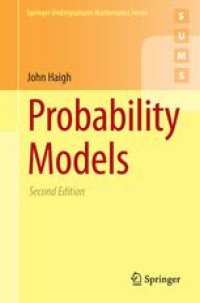
Ebook: Probability Models
Author: John Haigh (auth.)
- Tags: Probability Theory and Stochastic Processes, Simulation and Modeling, Probability and Statistics in Computer Science, Operation Research/Decision Theory, Mathematical Applications in Computer Science, Mathematical Applications in the Phy
- Series: Springer Undergraduate Mathematics Series
- Year: 2013
- Publisher: Springer-Verlag London
- Edition: 2
- Language: English
- pdf
The purpose of this book is to provide a sound introduction to the study of real-world phenomena that possess random variation. It describes how to set up and analyse models of real-life phenomena that involve elements of chance. Motivation comes from everyday experiences of probability, such as that of a dice or cards, the idea of fairness in games of chance, and the random ways in which, say, birthdays are shared or particular events arise. Applications include branching processes, random walks, Markov chains, queues, renewal theory, and Brownian motion. This popular second edition textbook contains many worked examples and several chapters have been updated and expanded. Some mathematical knowledge is assumed. The reader should have the ability to work with unions, intersections and complements of sets; a good facility with calculus, including integration, sequences and series; and appreciation of the logical development of an argument. Probability Models is designed to aid students studying probability as part of an undergraduate course on mathematics or mathematics and statistics.
The purpose of this book is to provide a sound introduction to the study of real-world phenomena that possess random variation. It describes how to set up and analyse models of real-life phenomena that involve elements of chance. Motivation comes from everyday experiences of probability, such as that of a dice or cards, the idea of fairness in games of chance, and the random ways in which, say, birthdays are shared or particular events arise.
Applications include branching processes, random walks, Markov chains, queues, renewal theory, and Brownian motion. This popular second edition textbook contains many worked examples and several chapters have been updated and expanded.
Some mathematical knowledge is assumed. The reader should have the ability to work with unions, intersections and complements of sets; a good facility with calculus, including integration, sequences and series; and appreciation of the logical development of an argument.
Probability Models is designed to aid students studying probability as part of an undergraduate course on mathematics or mathematics and statistics.
The purpose of this book is to provide a sound introduction to the study of real-world phenomena that possess random variation. It describes how to set up and analyse models of real-life phenomena that involve elements of chance. Motivation comes from everyday experiences of probability, such as that of a dice or cards, the idea of fairness in games of chance, and the random ways in which, say, birthdays are shared or particular events arise.
Applications include branching processes, random walks, Markov chains, queues, renewal theory, and Brownian motion. This popular second edition textbook contains many worked examples and several chapters have been updated and expanded.
Some mathematical knowledge is assumed. The reader should have the ability to work with unions, intersections and complements of sets; a good facility with calculus, including integration, sequences and series; and appreciation of the logical development of an argument.
Probability Models is designed to aid students studying probability as part of an undergraduate course on mathematics or mathematics and statistics.
Content:
Front Matter....Pages I-XII
Probability Spaces....Pages 1-22
Conditional Probability and Independence....Pages 23-45
Common Probability Distributions....Pages 47-62
Random Variables....Pages 63-97
Sums of Random Variables....Pages 99-130
Convergence and Limit Theorems....Pages 131-152
Stochastic Processes in Discrete Time....Pages 153-184
Stochastic Processes in Continuous Time....Pages 185-240
Appendix: Common Distributions and Mathematical Facts....Pages 241-244
Back Matter....Pages 245-287
The purpose of this book is to provide a sound introduction to the study of real-world phenomena that possess random variation. It describes how to set up and analyse models of real-life phenomena that involve elements of chance. Motivation comes from everyday experiences of probability, such as that of a dice or cards, the idea of fairness in games of chance, and the random ways in which, say, birthdays are shared or particular events arise.
Applications include branching processes, random walks, Markov chains, queues, renewal theory, and Brownian motion. This popular second edition textbook contains many worked examples and several chapters have been updated and expanded.
Some mathematical knowledge is assumed. The reader should have the ability to work with unions, intersections and complements of sets; a good facility with calculus, including integration, sequences and series; and appreciation of the logical development of an argument.
Probability Models is designed to aid students studying probability as part of an undergraduate course on mathematics or mathematics and statistics.
Content:
Front Matter....Pages I-XII
Probability Spaces....Pages 1-22
Conditional Probability and Independence....Pages 23-45
Common Probability Distributions....Pages 47-62
Random Variables....Pages 63-97
Sums of Random Variables....Pages 99-130
Convergence and Limit Theorems....Pages 131-152
Stochastic Processes in Discrete Time....Pages 153-184
Stochastic Processes in Continuous Time....Pages 185-240
Appendix: Common Distributions and Mathematical Facts....Pages 241-244
Back Matter....Pages 245-287
....